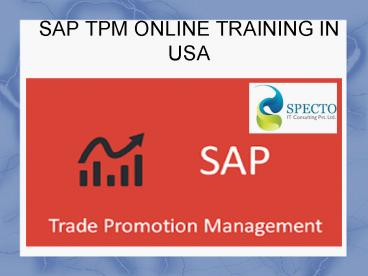SAP TPM ONLINE TRAINING IN USA
Title: SAP TPM ONLINE TRAINING IN USA
1
SAP TPM ONLINE TRAINING IN USA
2
SAP TPM ONLINE TRAINING IN USA
- SPECTO IT TRAINING
- CONTACT US
- INDIA91 9533456356
- USA1-847-787-7647
- Visit Our Websites
- Mailinfo_at_spectoittraining.com
- www.saponlinetraining.in
- https//www.facebook.com/spectoittraining
3
History of TPM
- TPM evolved from TQM, Which evolved as a direct
result of Dr. W. Edwards Deming's influence on
Japanese industry. - Dr. Deming initially began to show the Japanese
how to use statistical analysis in manufacturing
and how to use the resulting data to control
quality during manufacturing. - This new manufacturing concept eventually became
knows as Total Quality Management or TQM.
4
What is TPM ?
- TPM is a innovative Japanese concept.
- TPM is a LEAN tool to optimize the effectiveness
of manufacturing equipment and tooling. - We can also say that it can be the Medical
science of Machines.
5
Why TPM ?
- TPM was introduced to achieve the following
purposes. - Avoid wastage in a quickly changing economic
environment. - Producing goods without reducing product quality.
- Reduce cost.
- Produce a low batch quantity at the earliest
possible time. - Goods send to the customers must be non defective.
6
Objectives of TPM
- To markedly increase production while, at the
same time, increase employee morale and job
satisfaction. - To hold emergency and unscheduled maintenance to
a minimum. - To create a lean organization with reduced cycle
time and improved operational efficiency.
7
Objectives of TPM
- Improving productivity by highly motivated
workers which is achieved by job enlargement. - The use of voluntary small group activities for
identifying the cause of failure, possible plant
and equipment modifications. - Achieve zero defects, zero breakdown and zero
accidents in all functional areas of the
organization.
8
What is OEE ?
Overall Equipment Efficiency OEE A X P X Q A
Availability P Performance Q Quality
9
How to calculate OEE ?
Availability
10
Pillars of TPM
11
2. Jishu Hozen/ Autonomous Maintenance
- This pillar develops operator to take care of
small maintenance tasks . - Resulting skilled maintenance team to
concentrate on value added and technical repairs
. - The operator responsible for up keep of their
equipment to prevent it from deteriorating
12
Steps in Jishu Hozen
- Preparation of employees
- Initial cleanup of machines
- Take counter measures
- Fix tentative JH activities standards
- General Inspection
- Autonomous inspection
- Standardization
- Autonomous maintenance
13
3. Kaizen
- Kaizen made of two words- Kai means Change
Zen means Good - Policy of Kaizen-
- Practice concept of zero losses in every sphere
of activity. - Relentless pursuit to improve over all plant
equipment effectiveness and to achieve cost
reduction targets in all resources. - Focus of easy handling of operator.
14
Kaizen
- Tools used in Kaizen-
- PM analysis
- Why-Why analysis
- Summary of losses
- Kaizen register
- Kaizen summary sheet
15
4. Planned Maintenance
- This pillar aimed towards-
- Trouble free machines and equipment.
- Producing defect free products for total
customer satisfaction. - 4 type categories of maintenance-
- Preventive Maintenance
- Breakdown Maintenance
- Corrective Maintenance
- Maintenance Prevention
- Benefits-
- Achieve and sustainavailability of machines
- Optimum maintenance cost
16
5. Quality Maintenance
- This pillar aimed towards-
- Customer delight through highest quality
- Defect free manufacturing
- Eliminating non conformances in a systematic
manner - Reactive to proactive like (quality control to
quality assurance) - Benefits-
- Defect free condition and control of equipment
- Qm activity to control quality assurance
- Focus of prevention of defects at source
- Focus on poka-yoke (fool proof system)
17
6. Training
- This pillar aimed towards-
- Developing multiskill employees whose morale is
high and who has eager to come to work and
perform all required functions effectively and
independently - Employees will be trained to address the problem
by finding the - root cause eliminating them
- The goal is to create a factory full of experts
- Benefits-
- Achieve and sustain zero losses due to lack of
knowledge /skills /technique - Remove fatigue and make work more enjoyable
- Upgrading the operating maintenance skills
18
7. Office TPM
- This pillar aimed towards-
- To improve productivity
- Efficiency in the administrative functions and
identify to eliminate losses - Analyzing processes and procedures towards
increased office automation - Benefits-
- Inventory reduction
- Lead time reduction of critical process
- Equalizing the work load
- Retrieval time reduction (reduce repetitive
work) - Better utilized work area
- Reduction in administrative costs
19
8. Safety, Health Environment
- This pillar aimed towards-
- Create safe work place and safe work practice
- This pillar play vital role with other pillars on
regular basis - Benefits-
- Zero accident
- Zero fires
- Zero health damages
- Safe working condition
- Safe work practice
20
SAP TPM ONLINE TRAINING IN USA

